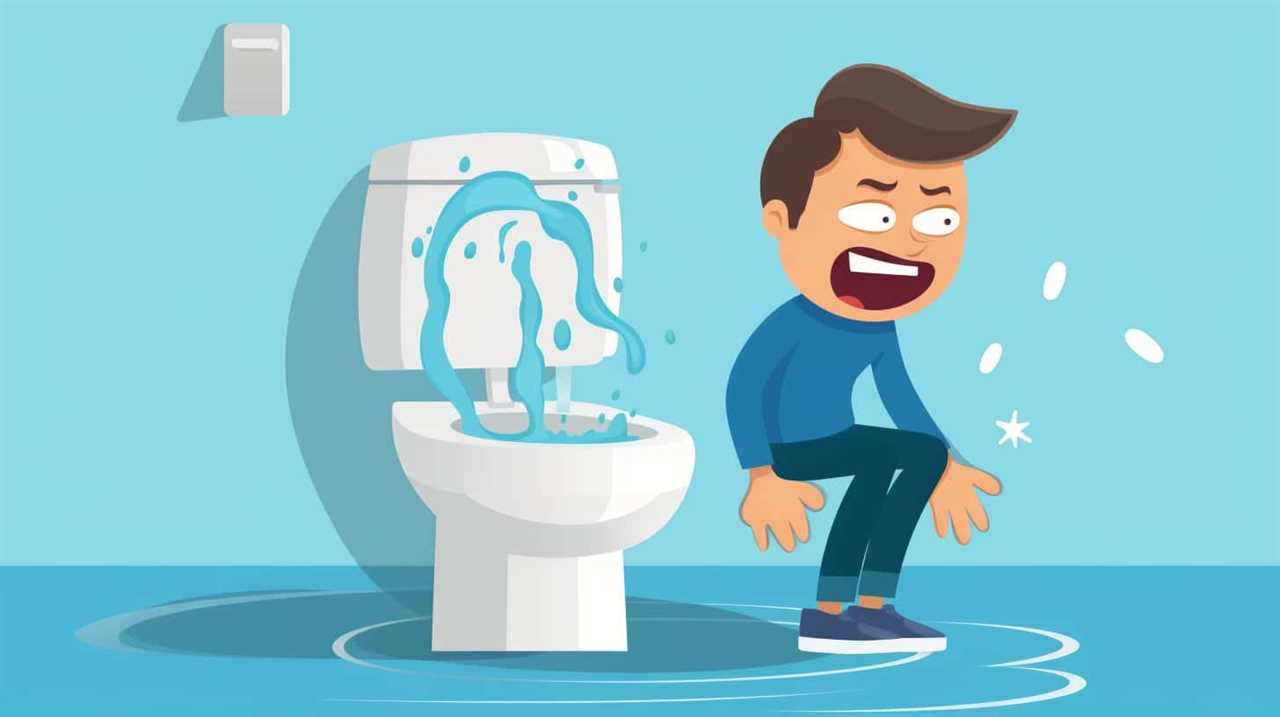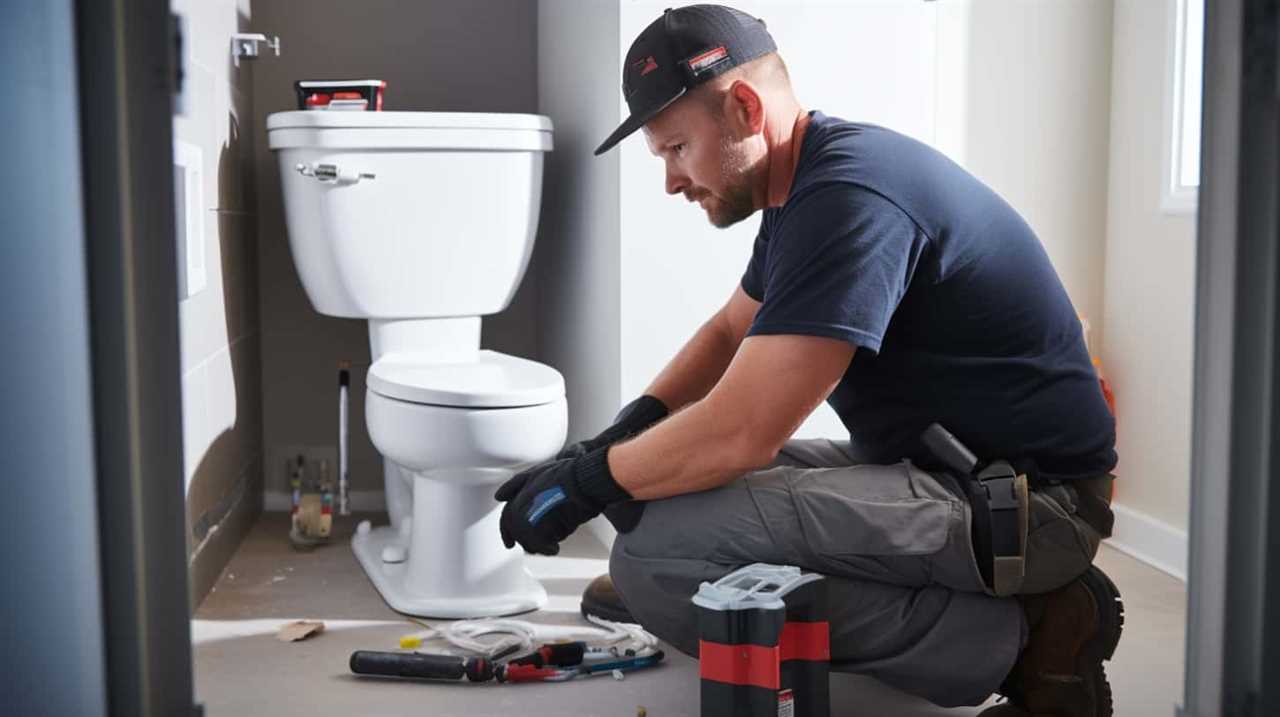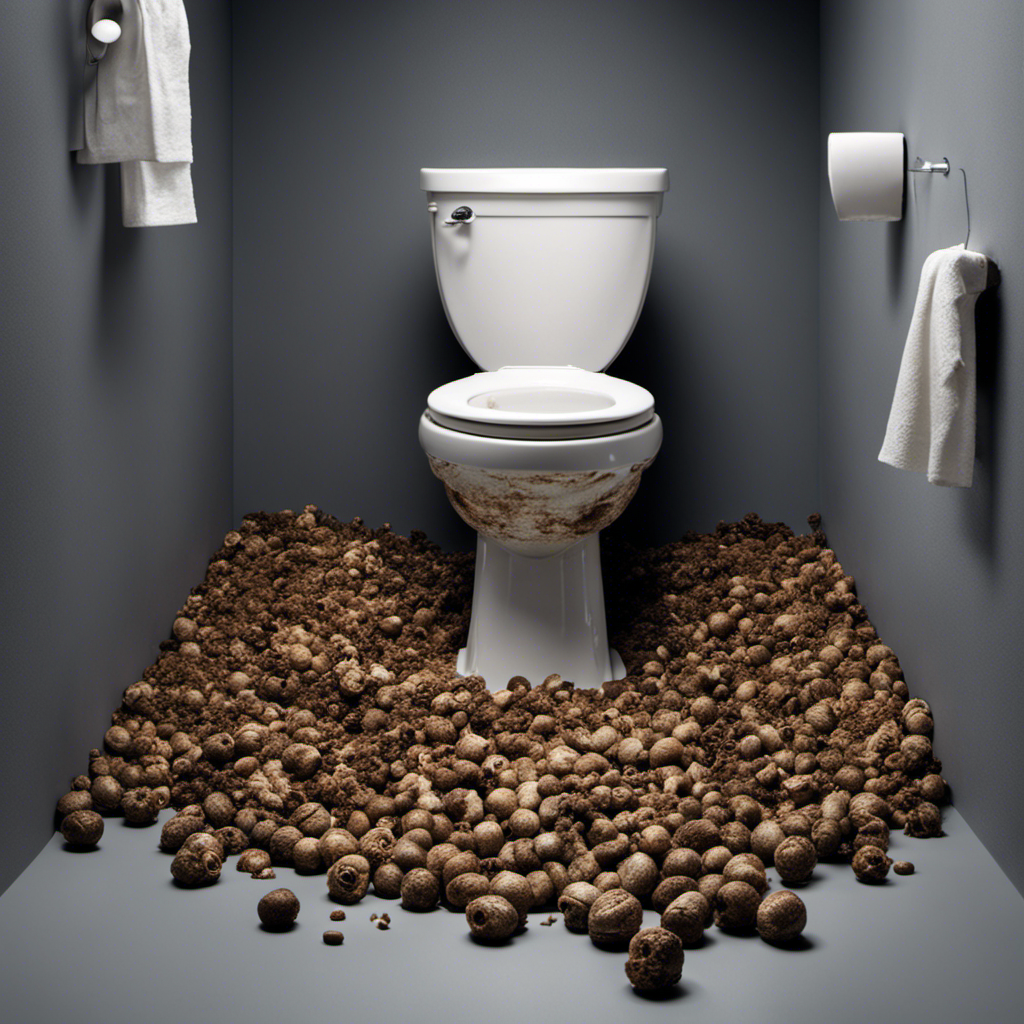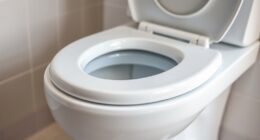Everyone has been there: you flush the toilet and then realize it hasn’t all gone down, necessitating another flush. Were you aware that almost 40% of toilets need a second flush to completely empty the bowl?
There are several reasons behind this frustrating phenomenon. From insufficient water pressure to clogs in the pipes, various factors can contribute to the need for a double flush.
In this article, we’ll explore the common causes and possible solutions for why your toilet might be demanding that second flush.
Key Takeaways
- Low water pressure is a common reason for toilets requiring two flushes.
- Partial clogs in the pipes can cause toilets to need multiple flushes.
- Debris accumulation in the pipes can result in partial clogs and the need for multiple flushes.
- Low-flow toilets conserve water but often require multiple flushes due to reduced water volume per flush.
Insufficient Water Pressure
We often find that low water pressure is the main reason why our toilets require two flushes. Insufficient water pressure can prevent an adequate amount of water from flowing into the toilet bowl, resulting in incomplete flushing. This issue can be attributed to various factors, such as outdated plumbing systems, clogged pipes, or problems with the water supply.

To address this problem and improve water efficiency, there are a few potential solutions. Firstly, checking the water pressure regulator and adjusting it to the recommended level can ensure optimal flow.
Secondly, installing a pressure-assisted toilet can provide a boost in flushing power.
Lastly, if the issue persists, consulting a professional plumber can help identify and address any underlying problems with the water supply or plumbing system.
Partial Clogs in the Pipes
We need to address the issue of partial clogs in the pipes.

This occurs when there’s insufficient water flow, causing debris to accumulate and obstruct the pipes.
When this happens, it can lead to toilets needing multiple flushes to clear the clog completely.
Insufficient Water Flow
Sometimes, toilet flushes may require two attempts due to insufficient water flow caused by partial clogs in the pipes. This happens when debris accumulates in the pipes, obstructing the water flow and reducing the force of the flush. The inadequate water flow prevents the toilet bowl from being properly cleared in one flush, resulting in the need for a second attempt.
Here are a few reasons why insufficient water flow can occur:

- The water level in the toilet tank is too low, limiting the amount of water available for the flush.
- Sediment or mineral deposits in the pipes restrict the flow of water.
- Small objects or foreign materials get trapped in the pipes, causing partial clogs.
- The flush valve or flapper in the toilet tank isn’t functioning correctly, impeding water flow.
Insufficient water flow due to partial clogs can lead to further issues, such as debris accumulation in pipes, which we’ll discuss in the next section.
Debris Accumulation in Pipes
As we continue our discussion on the reasons behind the need for two flushes, let’s now delve into the issue of debris accumulation in pipes, resulting in partial clogs.
Debris buildup is a common problem that can occur in our plumbing systems over time. When debris such as hair, grease, or small objects make their way into the pipes, they can gradually accumulate and form blockages.
These partial clogs restrict the flow of water, leading to inefficient flushing and the need for multiple flushes. It’s important to address this issue promptly to prevent further pipe blockage and potential plumbing issues.

Regular maintenance, such as using drain filters and periodically clearing the pipes with pipe snakes or hydro jetting, can help prevent debris buildup and ensure proper toilet functionality.
Low-Flow Toilet Design
Low-flow toilets, designed to conserve water, often require multiple flushes to effectively clear the bowl. However, their water-saving benefits make them a popular choice for environmentally conscious individuals.
Here are some key features of low-flow toilet design:
- Smaller water tank: Low-flow toilets typically have a smaller water tank compared to traditional toilets. This helps reduce the amount of water used per flush.
- Improved flushing mechanisms: These toilets are equipped with advanced flushing mechanisms, such as pressure-assisted or dual-flush systems, which provide better flushing performance using less water.
- Efficient bowl shape: Low-flow toilets have a specially designed bowl shape that helps to maximize the effectiveness of each flush.
- Water-saving certifications: Many low-flow toilets carry water-saving certifications, such as the WaterSense label, indicating that they meet specific efficiency standards.
Understanding the design elements of low-flow toilets can help homeowners make informed decisions about low flow toilet maintenance and the benefits of these water-saving fixtures.

Inadequate Flushing Power
We often experience a lack of flushing power with our low-flow toilets. This issue arises due to the reduced water volume used for each flush. While low-flow toilets are designed to conserve water, they can sometimes struggle to effectively remove waste.
Several factors contribute to inadequate flushing power, including insufficient water pressure, clogged or blocked drain pipes, and faulty flushing mechanisms. To address this problem, there are a few potential solutions.
Firstly, checking water pressure and ensuring it meets the recommended levels can improve flushing performance.
Secondly, regularly inspecting and maintaining drain pipes to prevent clogs or blockages is essential.

Additionally, replacing faulty flushing mechanisms, such as flapper valves or fill valves, can also help restore flushing power.
Faulty Flapper or Flush Valve
One common cause of the need for two flushes is a malfunctioning flapper or flush valve. These components are responsible for regulating the flow of water from the toilet tank into the bowl during a flush. When they’re faulty, they may not open fully or close properly, leading to inadequate flushing power.
Here are some reasons why a faulty flapper or flush valve can cause the need for two flushes:
- The flapper doesn’t lift high enough, restricting the amount of water that enters the bowl.
- The flapper closes too quickly, preventing a thorough flush.
- The flush valve isn’t sealing properly, causing water to leak into the bowl.
- The water level in the toilet tank is too low, resulting in insufficient force during the flush.
Addressing these issues by repairing or replacing the flapper or flush valve can help ensure a more efficient flush and prevent the need for multiple flushes.

Mineral Build-Up in the Bowl
Due to the presence of mineral build-up in the bowl, we may experience the need for two flushes. Mineral build-up occurs when the water in the toilet bowl contains high levels of minerals, such as calcium and magnesium. These minerals can come from the water supply, especially if it’s hard water, which is common in many areas.
Over time, these minerals can accumulate in the toilet bowl, forming a stubborn layer of deposits. This build-up can cause several issues, including clogging and inefficient flushing. Additionally, the minerals can react with the water, resulting in rusty pipes and hard water stains.
To prevent mineral build-up, regular cleaning with appropriate cleaning agents and the use of water softeners can be effective solutions.
Poorly Adjusted Flush Mechanism
When it comes to a poorly adjusted flush mechanism, there are two main issues that can contribute to the need for multiple flushes.

The first is inefficient water flow, which can result in a lack of force to effectively remove waste from the bowl.
The second is a faulty seal mechanism, which can cause water to leak or not properly fill the tank, leading to a weaker flush.
Both of these issues can be addressed by adjusting or replacing the flush mechanism, ensuring optimal performance and reducing the need for multiple flushes.
Inefficient Water Flow
Our toilets may require two flushes due to inefficient water flow caused by a poorly adjusted flush mechanism. When the flush mechanism isn’t properly adjusted, it can result in inadequate water flow during the flushing process. This can lead to inefficient water usage and the need for multiple flushes to completely clear the bowl.

To address this issue, it’s important to adjust the flush mechanism properly to ensure optimal water flow. Here are some water conservation measures to consider:
- Regularly check and adjust the flush mechanism to ensure proper water flow.
- Install a dual flush system that allows for different water volumes depending on the waste being flushed.
- Consider upgrading to a more efficient toilet model that uses less water per flush.
- Educate household members on proper flushing techniques to minimize the need for additional flushes.
Faulty Seal Mechanism
To address the issue of a faulty seal mechanism, we need to adjust the flush mechanism properly.
A common problem with toilets is a poorly adjusted flush mechanism, which can result in a faulty seal. This can lead to water leakage and the need for multiple flushes.
The seal mechanism is responsible for sealing the toilet bowl and preventing water from leaking out. If the seal isn’t properly adjusted, it may not create a tight seal, causing water to leak out when flushing.

To fix this issue, adjusting the flush mechanism is necessary. This involves ensuring that the flush valve is aligned properly and the flapper or ballcock is adjusted to the correct height.
If the seal problem persists, a toilet seal replacement may be required.
Large Waste Volume
The large waste volume in our toilets often requires us to use two flushes. This can be attributed to various factors including the toilet efficiency and waste disposal. Here are some reasons why our toilets struggle with large waste volume:
- Inadequate water flow: Insufficient water flow can lead to incomplete waste removal, necessitating a second flush.
- Low water level: If the water level in the toilet bowl is low, it may not provide enough force to properly flush away larger waste volumes.
- Clogged drain pipes: A buildup of debris or foreign objects in the drain pipes can impede the flow of waste, causing it to accumulate and require multiple flushes.
- Toilet design: Some toilets may not be designed to handle larger waste volumes efficiently, resulting in the need for additional flushes.
Understanding these factors can help us identify and address the issue of large waste volume in our toilets, ensuring more effective waste disposal and improved toilet efficiency.

Obstructions in the Trapway
We often encounter the need for two flushes due to obstructions in the trapway. The trapway is the curved passageway in the toilet that connects the bowl to the drainage pipe.
Regular toilet trapway maintenance is crucial to prevent common causes of toilet clogs. Over time, debris such as toilet paper, hair, and even small objects can accumulate in the trapway, causing partial or complete blockages. These obstructions prevent water from flowing smoothly through the trapway, resulting in inadequate flushing.
To avoid this issue, it’s important to regularly clean the trapway using a toilet brush or a plumber’s snake. Additionally, using toilet paper that’s specifically designed to break down easily can help prevent obstructions in the trapway.
Toilet Bowl Shape and Size
One possible reason for the need for two flushes in our toilets is the size and shape of the toilet bowl. The size and shape of the toilet bowl can affect the flow of water and the efficiency of flushing.

Here are some factors to consider:
- Bowl design: The shape and contour of the bowl can impact the water flow and how effectively it rinses the bowl.
- Bowl capacity: A larger bowl can hold more waste and may require more water to flush effectively.
- Rim design: The placement and design of the rim jets can affect the distribution of water and the effectiveness of cleaning the bowl.
- Material: The type of material used in the construction of the bowl, such as porcelain or ceramic, can impact its durability and maintenance requirements.
Understanding these factors can help in choosing a toilet bowl that meets your needs and ensures efficient flushing. However, if your toilet still requires multiple flushes, it may be due to aging or worn-out components.
Aging or Worn-Out Components
As we explore the reasons why a toilet may require two flushes, one possible cause could be aging or worn-out components. Faulty flapper valves can lead to incomplete sealing, resulting in water leakage and inadequate flushing.
Additionally, a weak flush mechanism, such as a worn-out flush handle or a malfunctioning flush valve, may contribute to the need for multiple flushes.

Lastly, clogged water jets can impede the flow of water, reducing the effectiveness of a single flush.
Identifying and addressing these issues can help restore the toilet’s flushing efficiency.
Faulty Flapper Valve
After years of use, the toilet’s flapper valve becomes faulty, often due to aging or worn-out components. Maintaining and replacing the flapper valve is crucial for proper toilet function. Here are some important points to consider:
- Flapper valve maintenance is essential to prevent leaks and ensure a strong flush.
- Regularly inspect the flapper valve for any signs of wear or damage.
- Clean the flapper valve regularly to remove any mineral deposits or debris that may affect its performance.
- If maintenance is no longer sufficient, flapper valve replacement may be necessary to restore optimal flushing power.
Weak Flush Mechanism
Addressing a weak flush mechanism due to aging or worn-out components is essential for maintaining proper toilet function.

Over time, the various components of a toilet, such as the fill valve, flush valve, and flapper, can deteriorate, leading to a weak flush. This can result in incomplete waste removal and the need for multiple flushes.
To resolve this issue, regular toilet maintenance is crucial. Firstly, check the fill valve to ensure it’s functioning properly and providing adequate water flow.
Secondly, inspect the flush valve for any signs of damage or wear.
Lastly, examine the flapper for any cracks or deformities that may be hindering its performance. If necessary, replace these components with high-quality, durable alternatives to restore optimal flushing power.

Clogged Water Jets
To continue addressing the issue of weak flush mechanisms, another common cause for toilets needing two flushes is clogged water jets resulting from aging or worn-out components. Clogged water jets can significantly diminish the flushing power of a toilet, causing waste to accumulate and requiring multiple flushes to clear it completely. Regular toilet maintenance is crucial to prevent clogs and ensure optimal performance.
Here are some tips to keep your toilet’s water jets clean and functioning properly:
- Use a toilet brush with stiff bristles to scrub the inside of the toilet bowl, paying special attention to the water jets.
- Avoid using harsh chemical cleaners that can damage the components and make clogs more likely.
- Periodically inspect the water jets for any buildup or debris and clean them as needed.
- Consider using a toilet cleaner specifically designed to remove mineral deposits and maintain the efficiency of the water jets.
Frequently Asked Questions
Can a Faulty Flapper or Flush Valve Cause a Toilet to Require Two Flushes?
A faulty flapper or flush valve can indeed cause a toilet to require two flushes. When these components are not functioning properly, they may not create a strong enough seal, leading to insufficient water flow and the need for multiple flushes.
How Can Mineral Build-Up in the Bowl Affect the Flushing Power of a Toilet?
Mineral build-up in the toilet bowl can reduce flushing power. It can cause clogs, leading to the need for multiple flushes. Cleaning solutions specifically designed to dissolve mineral deposits can help restore proper flushing efficiency.

Can a Poorly Adjusted Flush Mechanism Contribute to the Need for Multiple Flushes?
A poorly adjusted flush mechanism can indeed contribute to the need for multiple flushes. When the flush mechanism is not properly calibrated, it can result in insufficient water pressure, leading to incomplete flushing.
What Impact Does the Shape and Size of a Toilet Bowl Have on Its Flushing Efficiency?
Toilet design evolution has shown that the shape and size of the bowl can significantly impact flushing efficiency. The impact of water pressure on flushing efficiency is also noteworthy, as it can affect the effectiveness of a single flush.
Can Aging or Worn-Out Components in a Toilet System Lead to the Need for Multiple Flushes?
Aging or worn-out components in a toilet system can lead to the need for multiple flushes. Over time, parts like the flapper, fill valve, or flush lever may deteriorate, causing inadequate flushing efficiency.
Conclusion
In conclusion, it seems that there are various factors that could contribute to the need for two flushes in a toilet.

From insufficient water pressure to partial clogs in the pipes, low-flow toilet design, and even aging components, these issues can affect the flushing power.
By addressing these factors and ensuring proper maintenance, you can improve the efficiency of your toilet and avoid the need for multiple flushes.










